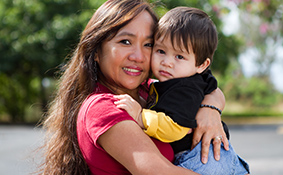While Medicaid eligibility is income-based, some people may qualify for Medicaid based on age, availability of financial resources or healthcare needs.
Medicaid provides free or low-cost healthcare coverage to qualifying individuals. Eligible groups include:
- Adults with a low income
- Children
- Pregnant women
- People age 65 or older
- People with disabilities
Individuals must meet other qualifications such as legal immigration status and state residency. Income and resource restrictions vary based on the eligibility pathway through which the individual qualifies.
What is the Federal Poverty Level?
The Federal Poverty Level (FPL) accounts for the minimum amount of gross income that a family needs for food, clothing, transportation, shelter and other necessities.1 The calculation is used to determine eligibility in multiple federal assistance programs. It is recalculated every year.
1
2
3
4
5
6
7
Each group of people eligible for Medicaid must meet certain FPL eligibility thresholds
Children between 6 and 18
Children can qualify for coverage through Medicaid or CHIP, the Children’s Health Insurance Program. States are required to extend Medicaid eligibility to children in families that make less than 138%* of FPL. However, eligibility limits vary by state and are often higher.2 *There is a 5% income disregard, making the effective minimum 133% FPL.
Pregnant women
States are required to extend eligibility to pregnant women in families that make less than 138% of FPL. However, many states have elected to increase the eligibility limit. The median FPL for Medicaid coverage for pregnant women is 201% FPL.3
Low-income working adults with no children
This group is eligible for Medicaid if their state has expanded eligibility under the Affordable Care Act. In most states, these low-income adults need to make less than 138% FPL or $17,226 per year if they are the only person in their household.
Sources
- Office of the Assistant Secretary for Planning and Evaluation: Poverty Guidelines
- "Medicaid and CHIP Income Eligibility Limits for Children as a Percent of the Federal Poverty Level." KFF. Jan, 2025.
- "Medicaid and CHIP Income Eligibility Limits for Pregnant Woman as a Percent of the Federal Poverty Level." KFF. Jan, 2025.
Examples of Medicaid eligibility
- Medicaid
- Pregnant women
- Medicaid expansion
- Activities of Daily Living (ADL)
- Dually eligible
Medicaid – children of low-income families
JJ is 10 years old and lives in Louisiana with his father and 8-year-old brother. This means there are three people in his household. His mother recently died after battling cancer. His dad is employed as a maintenance worker for a local property management company.
JJ’s dad earns $26,635/year.
JJ and his brother are covered under Medicaid because his dad earns less than $36,777/year.
Pregnant women
Tanya is a recently single mother with a six year old child who lives in Texas. She is pregnant and works full-time as a restaurant hostess making the federal minimum wage of $7.25 per hour. She works full-time and earns just over $15,000 a year. Because she has a child, her household size is 2 people.
Her child qualifies for Medicaid because she earns less than 138% of the Federal Poverty Level or $29,187 per year for a 2 person household.*
At this time Tanya also receives Temporary Assistance for Needy Families (TANF). TANF is a time-limited benefit program that helps parents or caregivers. Each state determines what benefits are available for those who qualify. In Texas, Tanya can receive a cash benefit to help with things like housing and childcare.
Since Tanya needs to earn less than $42,934.50 per year to qualify for Medicaid as a pregnant woman, she is also currently covered. However, once her child is born she will not qualify for Medicaid as a caregiver parent in Texas since she makes more than $3,172.50 per year, or 15% of the Federal Poverty Level with a household size of 3, and will no longer have health care coverage. Each state sets the Medicaid eligibility level for parents and caregivers of children and that level is approved by the federal government.
If Tanya’s state expanded Medicaid, she would qualify for Medicaid after giving birth since she makes less than $36,777 per year with a 3 person household.
Medicaid expansion
After working as an administrative assistant at the same company for more than 25 years, Lisa was part of a large lay off due to downsizing. She is currently working at a local grocery store while she is looking for another office position.
She earns the federal minimum wage of $7.25 per hour. She works an average of 35 hours a week, earning just over $1,000 a month.
Lisa qualifies for Medicaid after her state expanded Medicaid eligibility to low-income working adults and she makes less than $17,236 per year.
Example of person needing help with ADLs
Susan is an 80-year-old woman who was living on her own until she fell and broke a hip. Her doctor determined that she should move to a nursing home to recover from surgery. Susan was already on Medicaid due to her low income and small amount of assets and on Medicare because she is over 65 years old.
After recovering from her hip fracture, she was assessed to determine if she needed help with activities of daily living (ADLs). The assessment showed that she needed help dressing, walking from one place to another, using the bathroom and showering. She also needed help remembering to take her medications and eat three meals a day.
Based on the ADL assessment, Susan’s doctors and family agreed that she could no longer live at home and would need to be moved into a nursing facility for her safety.
Dually eligible
Rebecca is a 35-year-old woman who survived a serious car accident as a child, leaving her with physical and cognitive disabilities. Despite her disabilities, including the requirement to use a wheelchair, Rebecca lives independently with the help of Supplemental Security Income (SSI).
Rebecca has a part-time job at a local manufacturing facility. She earns $13 per hour, equaling roughly $15,600 a year.
Rebecca is a Dual Eligible because she qualifies for coverage under both Medicare and Medicaid. She qualifies for both Medicare and Medicaid because she’s permanently disabled and receives disability benefits. “Rebecca” would qualify on the basis of receipt of SSI, not on the basis of income. SSI recipients automatically qualify for Medicaid. In most states, this is an automatic process.
*Income limits may change based on the age of the child. Uninsured children may also be able to qualify for CHIP coverage.

